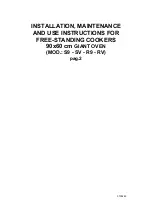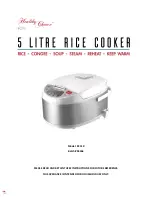
17.
Check that the main burner gas pressure is
maintained and unaffected when other gas
appliances are used.
18.
Check there is no spillage of combustion products
from the appliance down-draught diverter by carrying
out a spillage test as detailed in BS. 5440: 1 i.e. By
holding a smoke match so that the flame is
approximately 3mm up inside the lower edge of the
draught diverter. Spillage is indicated by the smoke
being displaced outward from the draught diverter.
Inspect flame pattern and appearance of burner at high
fire to establish that there is adequate air for combustion.
19.
Turn the control knob B to and remove the
pressure gauge from the burner test nipple, then
replace the sealing screw.
20.
Return control knob B to large flame symbol.
21.
Close outer burner door.
Overnight and when not required for cooking, leave
thermostat knob D at LOW position. To increase the
temperature of the oven or hotplate, turn the thermostat
knob D to required temperature setting.
See separate programmer operating instructions to set
the programmer if fitted.
Press and turn control knob B clockwise to off (
z
symbol)
whereupon the main cooker burner and the pilot burner
will extinguish.
NOTE: IF THE BURNER IS TO BE RE-LIT IN A DAY OR
TWO TURN THE CONTROL KNOB B TO SYMBOL
LEAVING THE PILOT ALIGHT. THE MAIN BURNER
WILL THEN LIGHT IMMEDIATELY YOU TURN
CONTROL KNOB B FROM TO AND THE
THERMOSTAT KNOB D TO REQUIRED SETTING.
ADVISE USER ABOUT THE FOLLOWING ITEMS ON
COMPLETION OF INSTALLATION.
(a) For continued efficient and safe operation of the
appliance, it is important that adequate servicing is
carried out at regular intervals.
6
HOW TO OPERATE
COOKER CONTROL
TO TURN OFF COOKER BURNER
A. OUTER BURNER DOOR
G. PRESSURE TEST NIPPLE
B. GAS CONTROL VALVE KNOB
H. PILOT BURNER HEAD
C. PIEZO SPARK GENERATOR
J. THERMOCOUPLE
D. THERMOSTAT KNOB
K. MAIN BURNER
E. SERVICE COCK
L. SOLENOID
F. SIGHT GLASS
M. GAS CONNECTION
BURNER ASSEMBLY
M
A
B
F
G
L
J
K
H
C
E
D
Fig. 7


































